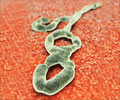Scientists at University of Texas Medical Branch at Galveston have identified a major biochemical link in the process by which the Ebola Zaire virus infects cells - a finding that
A major biochemical link in the process by which the Ebola Zaire virus infects cells - a finding that may provide potential treatment for hemorrhagic fever has been identified by scientists at University of Texas Medical Branch at Galveston.
Ebola produces severe and often fatal hemorrhagic fever in its victims and inflicts mortality rates close to 90 percent in some outbreaks.Till date, scientists haven't come up with a vaccine or antiviral therapy to fight against the virus, which is considered a high-risk agent for bioterrorism.
In the latest study, scientists tied Ebola's cellular invasion mechanism to a series of biochemical reactions called the phophoinositide-3 kinase pathway (named for an enzyme found in the cell membrane).
When they activated the PI3 kinase pathway, they found that an Ebola virus particle tricks the cell into drawing it into a bubble-like compartment known as an endosome, which is pulled, together with the virus, into the cell. Later, at a critical point, the virus bursts free from the endosome and begins to reproduce itself.
But, if the PI3 kinase pathway is shut down - as the UTMB team did with a drug designed for that purpose - Ebola virus particles can't escape from the endosome, and the disease process is hampered.
"The nice part about identifying entry mechanisms is you can prevent the virus from infecting the cell. You can stop the whole show before it even gets started," said Robert Davey, UTMB microbiology and immunology associate professor.
Advertisement
They also used a unique test created at UTMB that adds a light-emitting molecular beacon, called luciferase, to Ebola viruses and the virus-like particles. And this made them to determine exactly when and where each broke out of its bubble, and track its progress.
Advertisement
He pointed out that amongst all other viruses that had been found to activate the PI3 kinase pathway, Ebola was the first with envelope proteins that had been seen doing so.
It was also the first virus to be discovered interacting with the PI3 kinase pathway in order to enter cells, which could have profound implications.
"It's actually triggering the reorganizing of the cell for its own devious outcomes - infecting the cell. But there are other possible outcomes of fiddling around with the PI3 kinase. You can get the cell to move, you can get it to live longer, all advantages for a virus. So I'm sure that this is going to be important in other viruses," said Davey.
The scientists are also developing a new generation of drugs that target PI3 kinase, since the enzyme is often activated in cancers. It is possible that these could also be used to defend against Ebola virus.
The study is appearing online in the current issue of the journal PloS Pathogens.
Source-ANI
RAS/M














